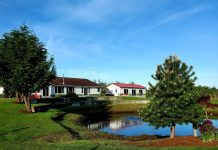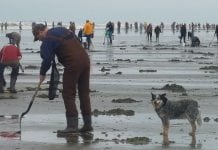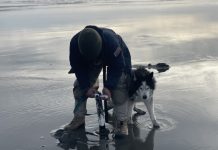This calendar is the place to find fun events happening throughout Grays Harbor County including Aberdeen, Hoquiam, Westport, Ocean Shores, Elma, Montesano and beyond.
Have an event that isn’t listed? Please email events@GraysHarborTalk.com with the following information:
- Name of Event
- Date, time and location (name of business if applicable and complete address)
- Organizer(s) name
- Cost
- URL to purchase tickets
- Website URL
- SHORT description of event
- Photo
Our editors will review and post within a few business days.
What you need to know
• Kids under 18 must be with parent or legal guardian
• All kids welcome regardless of what school they attend
• Bring your vaccination records for all vaccines – go
to https://wa.myir.net/rorl?next=/ to get your records!
• No immunization exemptions/waivers will be issued
• Vaccines available on a first-come, first-served basis
• Kids can get multiple vaccines as needed
• No appointment, insurance, or proof of residence needed!
What you need to know
• Kids under 18 must be with parent or legal guardian
• All kids welcome regardless of what school they attend
• Bring your vaccination records for all vaccines – go
to https://wa.myir.net/rorl?next=/ to get your records!
• No immunization exemptions/waivers will be issued
• Vaccines available on a first-come, first-served basis
• Kids can get multiple vaccines as needed
• No appointment, insurance, or proof of residence needed!

As part of the city’s 3rd annual Christmas in McCleary, the McCleary Civic Renewal Council is hosting the Jingle Bear Trot to accompany the city’s annual tree lighting celebration to mark the start of the holiday season. Enjoy our leisurely 1-mile or 5K trot around the Beerbower Park, which will be decorated in holiday lights and displays. Dress up in your
favorite holiday costume or bring jingle bells to help spread the cheer. Prizes will be awarded for best costumes!
$5 to trot
Costume Contest Categories
? Best family costume
? Most holiday themed
? Best kid costume (13 and younger)
? Best teen costume (14 and older)
Six days of razor clam digging at Mocrocks beaches starts Friday, Feb. 17, Copalis Beach opens Saturday, Feb. 18
OLYMPIA – Washington Department of Fish and Wildlife (WDFW) shellfish managers today confirmed razor clam digging reopens at Mocrocks beaches Friday, Feb. 17 followed by opportunities Feb. 19 and Feb. 21. This is in addition to Copalis Beach open on Saturday, Feb.18, Feb. 20, and Feb. 22.
“The forecast looks good for another six days of razor clam harvest on Copalis and Mocrocks only,” said Bryce Blumenthal, a WDFW coastal shellfish biologist. “That combined with later sunsets and deeper low tides should provide plenty of opportunity for successful digging.”
The following digs during evening (p.m.) low tides will proceed as scheduled:
- Feb. 17, Friday, 4:29 p.m.; -0.7 feet; Mocrocks
- Feb. 18, Saturday, 5:19 p.m.; -1.2 feet; Copalis
- Feb. 19, Sunday, 6:04 p.m.; -1.5 feet; Mocrocks
- Feb. 20, Monday, 6:46 p.m.; -1.4 feet; Copalis
- Feb. 21, Tuesday, 7:26 p.m.; -1.0 feet; Mocrocks
- Feb. 22, Wednesday, 8:05 p.m.; -0.3 feet; Copalis
The Washington Department of Health (WDOH) labs indicate domoic acid levels at Long Beach and Twin Harbors beaches were still above the health guideline levels. WDFW will announce future digging opportunities when marine toxin tests show it is safe to do so.
Domoic acid, a natural toxin produced by certain types of marine algae, can be harmful or fatal if consumed in sufficient quantities. WDFW shellfish staff will continue to regularly dig test samples of razor clams to monitor the situation. WDOH requires two test samples taken around seven days apart, must fall under the health guideline level before a beach can reopen for razor clam digging. More information about domoic acid, as well as current levels at ocean beaches, can be found on WDFW’s domoic acid webpage.
The daily limit is 15 razor clams per person. Under state law, a daily limit consists of the first 15 clams dug regardless of size or condition, and each digger’s clams must be kept in a separate container. Digging is prohibited in the razor clam reserve located just south of the Ocean City approach on Copalis, which are marked by 10-foot poles with signs. The most successful digging occurs between one and two hours before the listed time of low tide.
All diggers age 15 or older must have an applicable fishing license to harvest razor clams on any beach. Licenses may be purchased on WDFW’s licensing website, and from hundreds of license vendors around the state. WDFW recommends buying your license before visiting coastal beach communities.
For additional details, go to the WDFW’s razor clam webpage and the DOH webpage. To be notified of in-season rule changes as they are announced sign up for email notifications at wdfw.wa.gov/about/lists.
The Washington Department of Fish and Wildlife works to preserve, protect, and perpetuate fish, wildlife and ecosystems while providing sustainable fish and wildlife recreational and commercial opportunities.
Six days of razor clam digging at Mocrocks beaches starts Friday, Feb. 17, Copalis Beach opens Saturday, Feb. 18
OLYMPIA – Washington Department of Fish and Wildlife (WDFW) shellfish managers today confirmed razor clam digging reopens at Mocrocks beaches Friday, Feb. 17 followed by opportunities Feb. 19 and Feb. 21. This is in addition to Copalis Beach open on Saturday, Feb.18, Feb. 20, and Feb. 22.
“The forecast looks good for another six days of razor clam harvest on Copalis and Mocrocks only,” said Bryce Blumenthal, a WDFW coastal shellfish biologist. “That combined with later sunsets and deeper low tides should provide plenty of opportunity for successful digging.”
The following digs during evening (p.m.) low tides will proceed as scheduled:
- Feb. 17, Friday, 4:29 p.m.; -0.7 feet; Mocrocks
- Feb. 18, Saturday, 5:19 p.m.; -1.2 feet; Copalis
- Feb. 19, Sunday, 6:04 p.m.; -1.5 feet; Mocrocks
- Feb. 20, Monday, 6:46 p.m.; -1.4 feet; Copalis
- Feb. 21, Tuesday, 7:26 p.m.; -1.0 feet; Mocrocks
- Feb. 22, Wednesday, 8:05 p.m.; -0.3 feet; Copalis
The Washington Department of Health (WDOH) labs indicate domoic acid levels at Long Beach and Twin Harbors beaches were still above the health guideline levels. WDFW will announce future digging opportunities when marine toxin tests show it is safe to do so.
Domoic acid, a natural toxin produced by certain types of marine algae, can be harmful or fatal if consumed in sufficient quantities. WDFW shellfish staff will continue to regularly dig test samples of razor clams to monitor the situation. WDOH requires two test samples taken around seven days apart, must fall under the health guideline level before a beach can reopen for razor clam digging. More information about domoic acid, as well as current levels at ocean beaches, can be found on WDFW’s domoic acid webpage.
The daily limit is 15 razor clams per person. Under state law, a daily limit consists of the first 15 clams dug regardless of size or condition, and each digger’s clams must be kept in a separate container. Digging is prohibited in the razor clam reserve located just south of the Ocean City approach on Copalis, which are marked by 10-foot poles with signs. The most successful digging occurs between one and two hours before the listed time of low tide.
All diggers age 15 or older must have an applicable fishing license to harvest razor clams on any beach. Licenses may be purchased on WDFW’s licensing website, and from hundreds of license vendors around the state. WDFW recommends buying your license before visiting coastal beach communities.
For additional details, go to the WDFW’s razor clam webpage and the DOH webpage. To be notified of in-season rule changes as they are announced sign up for email notifications at wdfw.wa.gov/about/lists.
The Washington Department of Fish and Wildlife works to preserve, protect, and perpetuate fish, wildlife and ecosystems while providing sustainable fish and wildlife recreational and commercial opportunities.
Six days of razor clam digging at Mocrocks beaches starts Friday, Feb. 17, Copalis Beach opens Saturday, Feb. 18
OLYMPIA – Washington Department of Fish and Wildlife (WDFW) shellfish managers today confirmed razor clam digging reopens at Mocrocks beaches Friday, Feb. 17 followed by opportunities Feb. 19 and Feb. 21. This is in addition to Copalis Beach open on Saturday, Feb.18, Feb. 20, and Feb. 22.
“The forecast looks good for another six days of razor clam harvest on Copalis and Mocrocks only,” said Bryce Blumenthal, a WDFW coastal shellfish biologist. “That combined with later sunsets and deeper low tides should provide plenty of opportunity for successful digging.”
The following digs during evening (p.m.) low tides will proceed as scheduled:
- Feb. 17, Friday, 4:29 p.m.; -0.7 feet; Mocrocks
- Feb. 18, Saturday, 5:19 p.m.; -1.2 feet; Copalis
- Feb. 19, Sunday, 6:04 p.m.; -1.5 feet; Mocrocks
- Feb. 20, Monday, 6:46 p.m.; -1.4 feet; Copalis
- Feb. 21, Tuesday, 7:26 p.m.; -1.0 feet; Mocrocks
- Feb. 22, Wednesday, 8:05 p.m.; -0.3 feet; Copalis
The Washington Department of Health (WDOH) labs indicate domoic acid levels at Long Beach and Twin Harbors beaches were still above the health guideline levels. WDFW will announce future digging opportunities when marine toxin tests show it is safe to do so.
Domoic acid, a natural toxin produced by certain types of marine algae, can be harmful or fatal if consumed in sufficient quantities. WDFW shellfish staff will continue to regularly dig test samples of razor clams to monitor the situation. WDOH requires two test samples taken around seven days apart, must fall under the health guideline level before a beach can reopen for razor clam digging. More information about domoic acid, as well as current levels at ocean beaches, can be found on WDFW’s domoic acid webpage.
The daily limit is 15 razor clams per person. Under state law, a daily limit consists of the first 15 clams dug regardless of size or condition, and each digger’s clams must be kept in a separate container. Digging is prohibited in the razor clam reserve located just south of the Ocean City approach on Copalis, which are marked by 10-foot poles with signs. The most successful digging occurs between one and two hours before the listed time of low tide.
All diggers age 15 or older must have an applicable fishing license to harvest razor clams on any beach. Licenses may be purchased on WDFW’s licensing website, and from hundreds of license vendors around the state. WDFW recommends buying your license before visiting coastal beach communities.
For additional details, go to the WDFW’s razor clam webpage and the DOH webpage. To be notified of in-season rule changes as they are announced sign up for email notifications at wdfw.wa.gov/about/lists.
The Washington Department of Fish and Wildlife works to preserve, protect, and perpetuate fish, wildlife and ecosystems while providing sustainable fish and wildlife recreational and commercial opportunities.
Six days of razor clam digging at Mocrocks beaches starts Friday, Feb. 17, Copalis Beach opens Saturday, Feb. 18
OLYMPIA – Washington Department of Fish and Wildlife (WDFW) shellfish managers today confirmed razor clam digging reopens at Mocrocks beaches Friday, Feb. 17 followed by opportunities Feb. 19 and Feb. 21. This is in addition to Copalis Beach open on Saturday, Feb.18, Feb. 20, and Feb. 22.
“The forecast looks good for another six days of razor clam harvest on Copalis and Mocrocks only,” said Bryce Blumenthal, a WDFW coastal shellfish biologist. “That combined with later sunsets and deeper low tides should provide plenty of opportunity for successful digging.”
The following digs during evening (p.m.) low tides will proceed as scheduled:
- Feb. 17, Friday, 4:29 p.m.; -0.7 feet; Mocrocks
- Feb. 18, Saturday, 5:19 p.m.; -1.2 feet; Copalis
- Feb. 19, Sunday, 6:04 p.m.; -1.5 feet; Mocrocks
- Feb. 20, Monday, 6:46 p.m.; -1.4 feet; Copalis
- Feb. 21, Tuesday, 7:26 p.m.; -1.0 feet; Mocrocks
- Feb. 22, Wednesday, 8:05 p.m.; -0.3 feet; Copalis
The Washington Department of Health (WDOH) labs indicate domoic acid levels at Long Beach and Twin Harbors beaches were still above the health guideline levels. WDFW will announce future digging opportunities when marine toxin tests show it is safe to do so.
Domoic acid, a natural toxin produced by certain types of marine algae, can be harmful or fatal if consumed in sufficient quantities. WDFW shellfish staff will continue to regularly dig test samples of razor clams to monitor the situation. WDOH requires two test samples taken around seven days apart, must fall under the health guideline level before a beach can reopen for razor clam digging. More information about domoic acid, as well as current levels at ocean beaches, can be found on WDFW’s domoic acid webpage.
The daily limit is 15 razor clams per person. Under state law, a daily limit consists of the first 15 clams dug regardless of size or condition, and each digger’s clams must be kept in a separate container. Digging is prohibited in the razor clam reserve located just south of the Ocean City approach on Copalis, which are marked by 10-foot poles with signs. The most successful digging occurs between one and two hours before the listed time of low tide.
All diggers age 15 or older must have an applicable fishing license to harvest razor clams on any beach. Licenses may be purchased on WDFW’s licensing website, and from hundreds of license vendors around the state. WDFW recommends buying your license before visiting coastal beach communities.
For additional details, go to the WDFW’s razor clam webpage and the DOH webpage. To be notified of in-season rule changes as they are announced sign up for email notifications at wdfw.wa.gov/about/lists.
The Washington Department of Fish and Wildlife works to preserve, protect, and perpetuate fish, wildlife and ecosystems while providing sustainable fish and wildlife recreational and commercial opportunities.
Six days of razor clam digging at Mocrocks beaches starts Friday, Feb. 17, Copalis Beach opens Saturday, Feb. 18
OLYMPIA – Washington Department of Fish and Wildlife (WDFW) shellfish managers today confirmed razor clam digging reopens at Mocrocks beaches Friday, Feb. 17 followed by opportunities Feb. 19 and Feb. 21. This is in addition to Copalis Beach open on Saturday, Feb.18, Feb. 20, and Feb. 22.
“The forecast looks good for another six days of razor clam harvest on Copalis and Mocrocks only,” said Bryce Blumenthal, a WDFW coastal shellfish biologist. “That combined with later sunsets and deeper low tides should provide plenty of opportunity for successful digging.”
The following digs during evening (p.m.) low tides will proceed as scheduled:
- Feb. 17, Friday, 4:29 p.m.; -0.7 feet; Mocrocks
- Feb. 18, Saturday, 5:19 p.m.; -1.2 feet; Copalis
- Feb. 19, Sunday, 6:04 p.m.; -1.5 feet; Mocrocks
- Feb. 20, Monday, 6:46 p.m.; -1.4 feet; Copalis
- Feb. 21, Tuesday, 7:26 p.m.; -1.0 feet; Mocrocks
- Feb. 22, Wednesday, 8:05 p.m.; -0.3 feet; Copalis
The Washington Department of Health (WDOH) labs indicate domoic acid levels at Long Beach and Twin Harbors beaches were still above the health guideline levels. WDFW will announce future digging opportunities when marine toxin tests show it is safe to do so.
Domoic acid, a natural toxin produced by certain types of marine algae, can be harmful or fatal if consumed in sufficient quantities. WDFW shellfish staff will continue to regularly dig test samples of razor clams to monitor the situation. WDOH requires two test samples taken around seven days apart, must fall under the health guideline level before a beach can reopen for razor clam digging. More information about domoic acid, as well as current levels at ocean beaches, can be found on WDFW’s domoic acid webpage.
The daily limit is 15 razor clams per person. Under state law, a daily limit consists of the first 15 clams dug regardless of size or condition, and each digger’s clams must be kept in a separate container. Digging is prohibited in the razor clam reserve located just south of the Ocean City approach on Copalis, which are marked by 10-foot poles with signs. The most successful digging occurs between one and two hours before the listed time of low tide.
All diggers age 15 or older must have an applicable fishing license to harvest razor clams on any beach. Licenses may be purchased on WDFW’s licensing website, and from hundreds of license vendors around the state. WDFW recommends buying your license before visiting coastal beach communities.
For additional details, go to the WDFW’s razor clam webpage and the DOH webpage. To be notified of in-season rule changes as they are announced sign up for email notifications at wdfw.wa.gov/about/lists.
The Washington Department of Fish and Wildlife works to preserve, protect, and perpetuate fish, wildlife and ecosystems while providing sustainable fish and wildlife recreational and commercial opportunities.
Six days of razor clam digging at Mocrocks beaches starts Friday, Feb. 17, Copalis Beach opens Saturday, Feb. 18
OLYMPIA – Washington Department of Fish and Wildlife (WDFW) shellfish managers today confirmed razor clam digging reopens at Mocrocks beaches Friday, Feb. 17 followed by opportunities Feb. 19 and Feb. 21. This is in addition to Copalis Beach open on Saturday, Feb.18, Feb. 20, and Feb. 22.
“The forecast looks good for another six days of razor clam harvest on Copalis and Mocrocks only,” said Bryce Blumenthal, a WDFW coastal shellfish biologist. “That combined with later sunsets and deeper low tides should provide plenty of opportunity for successful digging.”
The following digs during evening (p.m.) low tides will proceed as scheduled:
- Feb. 17, Friday, 4:29 p.m.; -0.7 feet; Mocrocks
- Feb. 18, Saturday, 5:19 p.m.; -1.2 feet; Copalis
- Feb. 19, Sunday, 6:04 p.m.; -1.5 feet; Mocrocks
- Feb. 20, Monday, 6:46 p.m.; -1.4 feet; Copalis
- Feb. 21, Tuesday, 7:26 p.m.; -1.0 feet; Mocrocks
- Feb. 22, Wednesday, 8:05 p.m.; -0.3 feet; Copalis
The Washington Department of Health (WDOH) labs indicate domoic acid levels at Long Beach and Twin Harbors beaches were still above the health guideline levels. WDFW will announce future digging opportunities when marine toxin tests show it is safe to do so.
Domoic acid, a natural toxin produced by certain types of marine algae, can be harmful or fatal if consumed in sufficient quantities. WDFW shellfish staff will continue to regularly dig test samples of razor clams to monitor the situation. WDOH requires two test samples taken around seven days apart, must fall under the health guideline level before a beach can reopen for razor clam digging. More information about domoic acid, as well as current levels at ocean beaches, can be found on WDFW’s domoic acid webpage.
The daily limit is 15 razor clams per person. Under state law, a daily limit consists of the first 15 clams dug regardless of size or condition, and each digger’s clams must be kept in a separate container. Digging is prohibited in the razor clam reserve located just south of the Ocean City approach on Copalis, which are marked by 10-foot poles with signs. The most successful digging occurs between one and two hours before the listed time of low tide.
All diggers age 15 or older must have an applicable fishing license to harvest razor clams on any beach. Licenses may be purchased on WDFW’s licensing website, and from hundreds of license vendors around the state. WDFW recommends buying your license before visiting coastal beach communities.
For additional details, go to the WDFW’s razor clam webpage and the DOH webpage. To be notified of in-season rule changes as they are announced sign up for email notifications at wdfw.wa.gov/about/lists.
The Washington Department of Fish and Wildlife works to preserve, protect, and perpetuate fish, wildlife and ecosystems while providing sustainable fish and wildlife recreational and commercial opportunities.










































